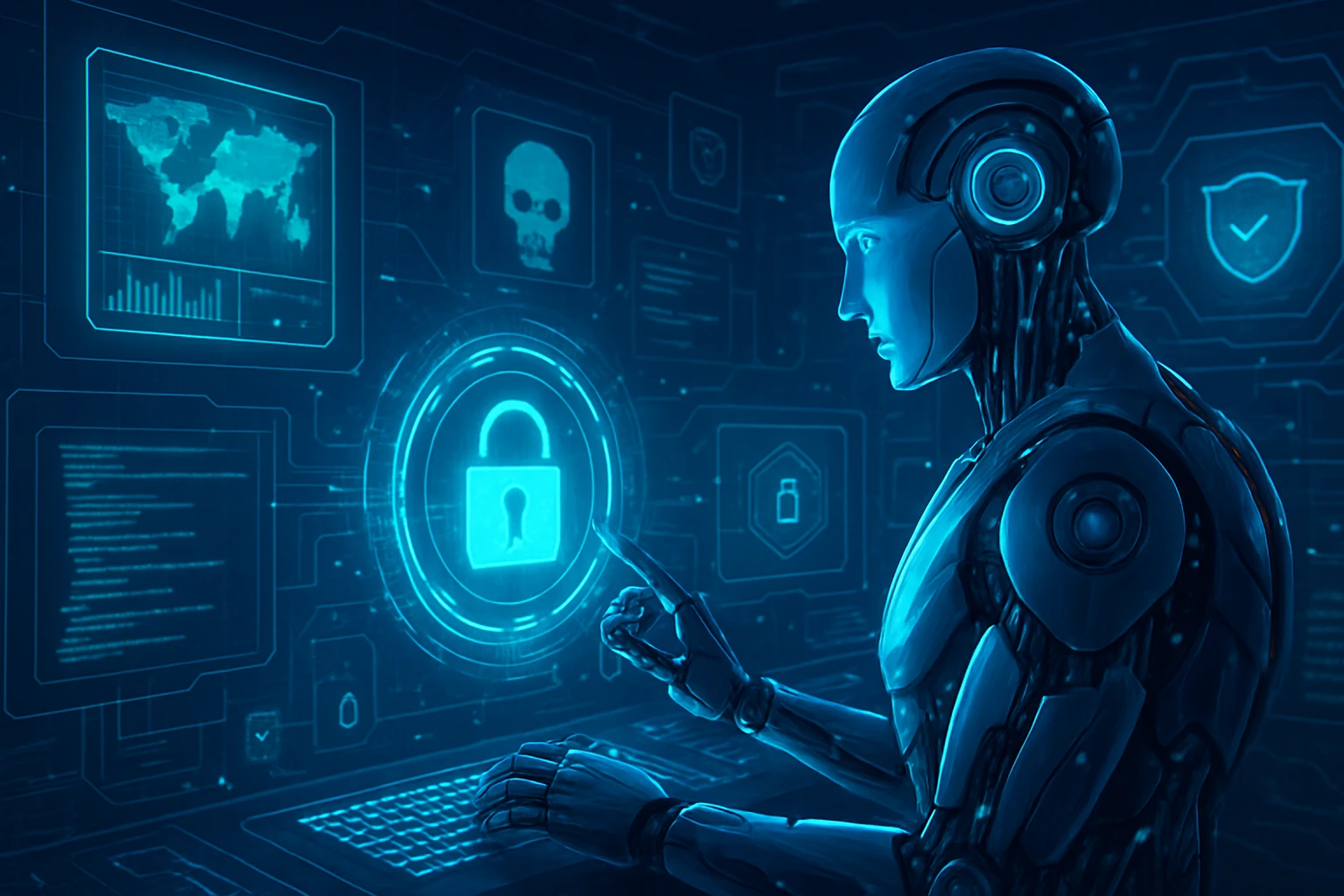
Does AI Hold the Key to Cybersecurity’s Future?
Here’s a wild stat to get us started: by the time you finish this paragraph, a new cyberattack has likely just launched somewhere in the world. Yep, that’s how fast and furious threats are coming at us these days. And honestly, it’s starting to feel like traditional cybersecurity methods are playing an exhausting game of digital whack-a-mole—patching here, scanning there, reacting everywhere.
But what if we flipped the narrative? Instead of reacting to threats *after* they happen, what if AI helped us stop them before they even had a chance to begin? Sound futuristic? It’s actually a future that’s already knocking on the door—and trust me, it’s worth opening.
Why the Old Ways Just Aren’t Cutting It
If you’re in IT or cybersecurity (and hey, I’ve been there), you know the drill: endless logs, alert fatigue, and too many hours spent chasing false positives. It’s like searching for a needle in a haystack, while more hay keeps flying in. And the bad guys? They’re not standing still. They’re using evasive malware, deepfakes, and even AI to break in. Yup, they’re bringing bots to the battle.
That’s where AI in cybersecurity slides in like the quiet superhero we’ve been waiting for. When trained right, AI can analyze patterns across oceans of data, spot anomalies in real-time, and even predict likely attack vectors before the first exploit fires off. Basically, it’s like having your own virtual SOC team that never sleeps or slacks off. Tempting, right?
3 Ways to Use AI in Cybersecurity Right Now
Here’s where it gets exciting—and useful. If you’re starting to think about integrating AI into your security stack, here are a few rock-solid places to begin:
- Threat Detection & Prediction: Machine learning models can analyze historical and live data to flag unusual behavior, like that one login attempt from an IP address in Mongolia at 3 AM. Not normal? AI agrees.
- User & Entity Behavior Analytics (UEBA): Set baselines for normal user activity and detect deviations. Think: if a user who usually logs in 9–5 suddenly starts downloading gigabytes of data at midnight? Red flag.
- Automated Incident Response: AI can help prioritize alerts based on severity and even trigger automated responses. That means faster defense and reduced pressure on your already-stretched team.
I worked with a fintech client recently who was drowning in SIEM alerts—like, tens of thousands a day. We implemented a basic AI-driven threat triaging system, and guess what? Alert noise went down by 70%, letting their team focus on *real* threats. Night. And. Day.
The Road Ahead: Smarter, Not Harder
Look, no one’s saying AI is going to be a silver bullet. It needs training, supervision, and—let’s be real—a healthy dose of human judgment to truly shine. But the direction is clear: the future of AI
So if you’ve been wondering whether AI is all hype, here’s your answer: it’s not just hype—it’s the next evolution. Stay ahead, stay smart, and get ready to protect your digital world with the kind of backup that *never blinks*.
The Current Landscape: AI in Cybersecurity
Did you know that over 70% of businesses faced a cybersecurity incident last year? Yep, even ones with firewalls taller than the Eiffel Tower. It’s kind of wild when you think about how hard we’re all trying to stay secure—and how fast the bad guys are evolving.
If you’re anything like me (part sleep-deprived IT wizard, part digital bodyguard), you know the cyber threat landscape isn’t just growing—it’s basically doing CrossFit. Every day, there’s a new exploit, a more sophisticated phishing scam, or some AI-powered malware slipping through traditional defenses like a ninja in the night.
Enter AI: Our High-Tech Ally
This is where Artificial Intelligence is starting to feel less like a buzzword and more like your smart, tireless partner in crime-fighting. We’re talking deep learning models that can sift through mountains of system logs in seconds—the kind of thing that would take us hours with a pot of overpriced coffee and some aspirin.
I’ve been working with an AI-powered threat detection tool recently (shoutout to Darktrace—seriously impressive stuff), and it’s like having an extra team member who never sleeps, doesn’t complain, and can recognize behavioral anomalies across an entire network before you even spot the red flag. It flagged a strange login pattern from a supposedly legit employee account—turned out, it was compromised. Pre-AI? That would have gone unnoticed for days. Painful.
Practical Ways to Get AI Working for You
Now you might be wondering, “Cool story, but how do I actually start using this stuff?” I got you. Here’s what I’ve seen work:
- Start small with AI-enhanced threat monitoring. Tools like Microsoft Defender for Endpoint or CrowdStrike Falcon use machine learning to detect real-time threats. You don’t have to invest in Skynet from day one—just dip your toes in.
- Automate repetitive tasks with AI. AI can handle things like patch management, false positive filtering, and user behavior analytics. That frees you up to focus on complex threats instead of babysitting alert dashboards all day.
- Train your security team on AI insights. It’s not just about plugging in tools—your team needs to understand how to interpret AI-driven alerts and act fast. Many platforms now offer built-in training modules, so lean into them.
Looking Ahead
Here’s the truth—AI isn’t here to replace you (or take your badge and your parking spot). It’s here to be your sidekick in a threat environment that’s just too fast-moving to tackle alone. The bots might be smarter now, but so are we—especially when we embrace the right tools.
So if you’re feeling overwhelmed by the tidal wave of attacks and alerts (believe me, I’ve been there), just remember: you’ve got help. And with AI riding shotgun, we’re not just reacting to threats anymore—we’re outsmarting them. How cool is that?
Breakthroughs in AI and Machine Learning
Did you know that AI-powered threat detection systems can now identify a cyberattack 60% faster than traditional methods? Sixty percent. That’s not just shaving a few minutes off—it’s like catching a burglar climbing in your window before they even cut the screen.
If you’ve been in the cybersecurity game for a while, you’ve probably seen AI evolve from flashy buzzword to “actually useful” tool. I remember when machine learning models felt more like guesswork than guardians. Now? They’re predicting malicious behavior before it even happens—like cybersecurity’s version of a crystal ball (but you know, with algorithms).
How AI Is Getting Smarter—And Faster
So what’s really changed? Well, machine learning isn’t just reactive anymore. It’s becoming predictive. That means these systems aren’t waiting for a threat to show up—they’re out there actively seeking it. Think of it like flipping from “lookout mode” to full-on “pursuit mode.” Pretty cool, right?
Here’s what’s behind the magic:
- Behavioral analytics: ML models are now trained on massive sets of user behavior data. We’re not just talking about obvious red flags, but subtle patterns that suggest something’s off. Like when Tom in accounting suddenly logs in at 3 a.m. from a country he’s never been to? Yeah, AI catches that.
- Natural language processing (NLP): AI can now analyze phishing emails by understanding word patterns and context—so even a cleverly worded scam gets flagged before it lands in someone’s inbox.
- Adversarial machine learning: New models are being trained to simulate how attackers think—so they can anticipate next moves in what’s basically a digital chess match.
How You Can Use These Breakthroughs Today
You don’t need to be Google to start taking advantage of these innovations. Seriously—there are strategic steps you can take right now:
- Adopt AI-Enabled Tools: Look for endpoint protection platforms (EPPs) or SIEM tools that use ML to not just detect, but prevent threats—like SentinelOne or Darktrace.
- Feed Your AI the Right Data: The more relevant and clean data you can provide, the smarter your system becomes. Make it a habit to use sanitized, labeled datasets—it’s the digital equivalent of eating your veggies.
- Train Your Team: Everyone loves automation, but humans still need to understand how models work. Set up internal lunch-and-learns or work with vendors who offer AI training tailored to security teams. You’ll thank yourself later.
Let me tell you, we rolled out an AI-powered anomaly detection system at our company a few months ago. Within days, it flagged an API behaving oddly—and we caught a low-and-slow attack probing for weaknesses. Before the AI implementation? That kind of thing might have slipped through for weeks.
A Brave (and Bright) New World
Yes, cyberthreats keep evolving—but so do we. With AI advancing this quickly, it’s boosting our chance to not just fend off threats but stay ahead of them. Imagine a future where networks defend themselves, malware gets blocked in real time, and your security team can focus on strategy instead of just putting out fires.
This isn’t science fiction. It’s where we’re headed. And the more you use AI, the smarter and safer your systems become.
So, ready to start training your digital watchdog? Let’s outsmart the smart threats—together.
Challenges Facing AI in Threat Detection
Did you know that over 85% of cybersecurity professionals believe AI will uncover threats faster — but only 38% fully trust it to make decisions on its own? Talk about a love-hate relationship, right?
It’s easy to get caught up in the AI hype when it comes to cybersecurity. I mean, who wouldn’t want a tireless digital partner that can scan thousands of logs per second and sniff out anomalies before your morning coffee kicks in? But here’s the thing — just because AI is smart, doesn’t mean it’s ready to go solo on the front lines.
I’ve seen this firsthand. Back when I was working with a mid-sized finance firm, we integrated a fancy threat detection AI to ease the burden on our small SOC team. The results? Mixed. The tool flagged lots — and I mean *LOTS* — of false positives. Our analysts went from playing defense to being flooded with alerts that ended up being harmless user activity. It was like training a dog to be a guard dog… and having it bark at literally everything, including the wind.
So what’s standing in AI’s way?
- Evolving threat landscapes: Hackers aren’t static — they adapt. When AI is trained on yesterday’s threats, it can miss today’s zero-day attacks or more covert, social engineering tactics head-on.
- Bias in models: AI is only as good as what it’s fed. If your training data’s biased or too narrow, your threat detection gets skewed. That’s how you end up blind to emerging attack vectors or too reactive to normal network behavior.
- Ethical concerns: There’s that tricky line between vigilance and surveillance. AI in cybersecurity can collect a scary amount of personal data. We have to be really thoughtful about privacy and consent.
Okay, now what? How can we make AI work *with* us, not against us?
Here’s what’s actually working out in the field — small tweaks, big impact:
- Human in the loop (HITL): Instead of letting AI run wild, keep a person overseeing its insights. That hybrid model — a smart AI + seasoned analyst — catches more threats and drastically reduces noise.
- Routinely retrain your models: Think of it like giving your AI a refresh button. Use diverse, up-to-date threat intel to keep it sharp. Schedule retraining sessions often, especially after major incidents or new malware campaigns emerge.
- Start small, then scale: Don’t throw AI at all your assets at once. Begin with defined use-cases, like phishing detection or endpoint monitoring. Test, tune, then expand with confidence.
We’re not replacing humans. We’re empowering them.
Here’s the exciting truth: AI isn’t here to steal jobs… it’s here to make incredible defenders even better. When paired thoughtfully, AI can be that extra brainpower we all need when alerts flood in at 2 A.M.
Sure, the road has bumps — but the teams embracing these challenges *with intention* are the ones leading confidently into the future. So keep questioning. Keep testing. And remember: In cybersecurity, the most powerful defense is an informed, agile team — with AI as your secret weapon.
Preparing for the AI-Driven Cyber Future
Did you know that over 80% of cybersecurity professionals believe AI will completely reshape the threat landscape in less than five years? Wild, right? That stat hit me like a ton of bricks the first time I heard it. And if you’re like most IT pros I know, you’re probably wondering: “Okay, so… how exactly do I stay on top of this tidal wave of change?”
Honestly, the rise of AI in cybersecurity can feel both thrilling and terrifying. On one hand, it’s like we’re getting superpowers—imagine real-time threat detection, predictive analytics, intelligent automation. Game-changing stuff! But flip the coin and there’s the dark side: AI-powered malware, hyper-targeted phishing, deepfakes that even your grandma could fall for (and trust me, she’s way sharper than she lets on).
So, how do we get ahead? How do we not just “manage” these changes but lead the charge in taming the AI beast? Here’s what I’ve found works—not just in theory, but out in the trenches:
1. Become a Lifelong AI Learner (Without Burning Out)
- Start small with AI fundamentals. Even carving out 15–30 minutes a day can get you familiar with key concepts like machine learning models, neural networks, and adversarial AI. I personally love Coursera’s “AI For Everyone” by Andrew Ng—friendly and digestible even after a long day of firewall configs and ticket queues.
- Join AI-focused communities. Reddit subs like r/MachineLearning or LinkedIn groups are low-effort ways to stay plugged in on trends and threats.
- Make AI part of your current projects. Automate that log analysis? Sure. Explore anomaly detection using AI scripts? Why not. Integrating AI where you already add value is a sneaky-smart way to level up without tossing your current job out the window.
2. Shift from Reactive to Proactive Defense
- Implement AI-powered tools today. Platforms like Darktrace and Vectra already offer real-time threat prediction and behavior-based detection. They’re not magic wands, but they do take manual grunt work off your plate.
- Test with Red Teams using AI attacks. I’ve seen teams run mock spear phishing campaigns powered by ChatGPT-like bots—what better way to understand your gaps than being outsmarted by your own trial attacks?
- Document lessons in a “living” playbook. You’ll be updating response strategies constantly. Having a dynamic, team-accessible playbook helps everyone stay aligned—and confident—in the chaos.
3. Rethink Your Career Path (Hint: AI Fluency is Gold)
- Look for roles in AI security, not just traditional infosec. Companies are hunting for cyber pros who “speak AI.” It’s this rare blend that sets you apart now.
- Earn certs that blend cybersecurity and AI. The CEH (Certified Ethical Hacker) now touches on AI vulnerabilities. Bonus points if you explore emerging microcredentials focused on AI governance and risk.
- Mentor others—or get a mentor yourself. My friend Nisha, a cloud security architect, started guiding a junior analyst through AI basics, and it sharpened *her* skills too. Giving back is a secret weapon for learning.
Here’s what’s exciting: we’re not spectators in this AI shift—we’re the shapers of it. We get to explore, experiment, and build a new cybersecurity frontier.
You don’t have to be an AI genius overnight. Start with curiosity. Add in community. Then take small, consistent steps. That’s how you stay ahead of the curve—not by sprinting, but by showing up and evolving, bit by bit.
The future’s not just coming—it’s already knocking. And honestly? It’s kind of awesome that we get to answer the door first.
Embrace the AI Cybersecurity Revolution
Did you know that over 60% of organizations say they’ve detected advanced threats that only AI could have caught? That stat stopped me in my tracks. It’s wild—and kind of exciting, right?
If you’ve been in IT or cybersecurity for any length of time, you know the grind: patching vulnerabilities, chasing false positives, and trying to stay a few steps ahead of threats that keep multiplying like digital gremlins. It’s exhausting. And let’s be real—sometimes it feels like brushing your teeth during a hurricane. There’s always another breach, another exploit, another zero-day freakout.
But—here’s the shift—we’re no longer fighting this war alone. Enter AI, not as a sci-fi villain, but as your new, slightly terrifying but hyper-efficient sidekick.
I remember the first time I watched a machine learning model flag anomalies in real time. I thought, “Okay, this is either magic or the beginning of the robot uprising.” Spoiler: it was magic… for our SecOps. Within weeks, incident response times dropped by 45%. And that’s not just us—major firms are reporting similar leaps forward.
So what can you do to embrace this AI-powered shift?
- Start small, but smart. You don’t need to overhaul your stack tomorrow. Begin by exploring AI tools that integrate with what you already use—especially for threat detection and behavioral analytics. Think of it like adding espresso to your security latte.
- Upskill your team—now. AI isn’t here to take your job, but it will change how your job works. Investing in AI and ML courses for your team is like learning to drive a faster, smarter car. You’ll still steer—it just won’t stall halfway through a breach.
- Make AI part of strategic decisions, not just reactive ones. Yeah, AI is amazing at risk scoring and anomaly detection. But it can also help forecast threats, model compliance outcomes, and even automate your pen testing. Use it not just to plug holes, but to blueprint stronger systems.
Here’s the exciting part: by embracing AI in cybersecurity, we’re not just defending ourselves better—we’re transforming the entire way industries operate. Healthcare, banking, manufacturing—everyone benefits when data is protected proactively and intelligently. We’re changing the game from reactive scrambling to confident monitoring.
So, what do you say—ready to be part of this evolution? You’ve already got the knowledge and instincts. Now is your moment to pair that expertise with AI’s capability and lead your team (and maybe your industry) into safer, smarter territory. Let’s stop chasing threats and start outsmarting them, together. 💪












